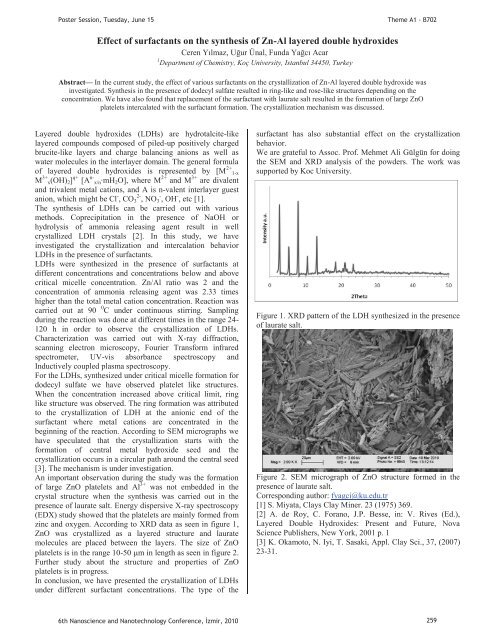Photonic crystals in biology
Photonic crystals in biology
Photonic crystals in biology
Create successful ePaper yourself
Turn your PDF publications into a flip-book with our unique Google optimized e-Paper software.
Poster Session, Tuesday, June 15<br />
Theme A1 - B702<br />
Effect of surfactants on the synthesis of Zn-Al layered double hydroxides<br />
Ceren Yılmaz, Uğur Ünal, Funda Yağcı Acar<br />
1 Department of Chemistry, Koç University, Istanbul 34450, Turkey<br />
Abstract— In the current study, the effect of various surfactants on the crystallization of Zn-Al layered double hydroxide was<br />
<strong>in</strong>vestigated. Synthesis <strong>in</strong> the presence of dodecyl sulfate resulted <strong>in</strong> r<strong>in</strong>g-like and rose-like structures depend<strong>in</strong>g on the<br />
concentration. We have also found that replacement of the surfactant with laurate salt resulted <strong>in</strong> the formation of large ZnO<br />
platelets <strong>in</strong>tercalated with the surfactant formation. The crystallization mechanism was discussed.<br />
Layered double hydroxides (LDHs) are hydrotalcite-like<br />
layered compounds composed of piled-up positively charged<br />
brucite-like layers and charge balanc<strong>in</strong>g anions as well as<br />
water molecules <strong>in</strong> the <strong>in</strong>terlayer doma<strong>in</strong>. The general formula<br />
of layered double hydroxides is represented by [M 2+ 1-x<br />
M 3+ x(OH) 2 ] q+ [A n- x/n·mH 2 O], where M 2+ and M 3+ are divalent<br />
and trivalent metal cations, and A is n-valent <strong>in</strong>terlayer guest<br />
anion, which might be Cl - , CO 2- 3 , NO - 3 , OH - , etc [1].<br />
The synthesis of LDHs can be carried out with various<br />
methods. Coprecipitation <strong>in</strong> the presence of NaOH or<br />
hydrolysis of ammonia releas<strong>in</strong>g agent result <strong>in</strong> well<br />
crystallized LDH <strong>crystals</strong> [2]. In this study, we have<br />
<strong>in</strong>vestigated the crystallization and <strong>in</strong>tercalation behavior<br />
LDHs <strong>in</strong> the presence of surfactants.<br />
LDHs were synthesized <strong>in</strong> the presence of surfactants at<br />
different concentrations and concentrations below and above<br />
critical micelle concentration. Zn/Al ratio was 2 and the<br />
concentration of ammonia releas<strong>in</strong>g agent was 2.33 times<br />
higher than the total metal cation concentration. Reaction was<br />
carried out at 90 0 C under cont<strong>in</strong>uous stirr<strong>in</strong>g. Sampl<strong>in</strong>g<br />
dur<strong>in</strong>g the reaction was done at different times <strong>in</strong> the range 24-<br />
120 h <strong>in</strong> order to observe the crystallization of LDHs.<br />
Characterization was carried out with X-ray diffraction,<br />
scann<strong>in</strong>g electron microscopy, Fourier Transform <strong>in</strong>frared<br />
spectrometer, UV-vis absorbance spectroscopy and<br />
Inductively coupled plasma spectroscopy.<br />
For the LDHs, synthesized under critical micelle formation for<br />
dodecyl sulfate we have observed platelet like structures.<br />
When the concentration <strong>in</strong>creased above critical limit, r<strong>in</strong>g<br />
like structure was observed. The r<strong>in</strong>g formation was attributed<br />
to the crystallization of LDH at the anionic end of the<br />
surfactant where metal cations are concentrated <strong>in</strong> the<br />
beg<strong>in</strong>n<strong>in</strong>g of the reaction. Accord<strong>in</strong>g to SEM micrographs we<br />
have speculated that the crystallization starts with the<br />
formation of central metal hydroxide seed and the<br />
crystallization occurs <strong>in</strong> a circular path around the central seed<br />
[3]. The mechanism is under <strong>in</strong>vestigation.<br />
An important observation dur<strong>in</strong>g the study was the formation<br />
of large ZnO platelets and Al 3+ was not embedded <strong>in</strong> the<br />
crystal structure when the synthesis was carried out <strong>in</strong> the<br />
presence of laurate salt. Energy dispersive X-ray spectroscopy<br />
(EDX) study showed that the platelets are ma<strong>in</strong>ly formed from<br />
z<strong>in</strong>c and oxygen. Accord<strong>in</strong>g to XRD data as seen <strong>in</strong> figure 1,<br />
ZnO was crystallized as a layered structure and laurate<br />
molecules are placed between the layers. The size of ZnO<br />
platelets is <strong>in</strong> the range 10-50 m <strong>in</strong> length as seen <strong>in</strong> figure 2.<br />
Further study about the structure and properties of ZnO<br />
platelets is <strong>in</strong> progress.<br />
In conclusion, we have presented the crystallization of LDHs<br />
under different surfactant concentrations. The type of the<br />
surfactant has also substantial effect on the crystallization<br />
behavior.<br />
We are grateful to Assoc. Prof. Mehmet Ali Gülgün for do<strong>in</strong>g<br />
the SEM and XRD analysis of the powders. The work was<br />
supported by Koc University.<br />
Figure 1. XRD pattern of the LDH synthesized <strong>in</strong> the presence<br />
of laurate salt.<br />
Figure 2. SEM micrograph of ZnO structure formed <strong>in</strong> the<br />
presence of laurate salt.<br />
Correspond<strong>in</strong>g author: fyagci@ku.edu.tr<br />
[1]S. Miyata, Clays Clay M<strong>in</strong>er. 23 (1975) 369.<br />
[2] A. de Roy, C. Forano, J.P. Besse, <strong>in</strong>: V. Rives (Ed.),<br />
Layered Double Hydroxides: Present and Future, Nova<br />
Science Publishers, New York, 2001 p. 1<br />
[3] K. Okamoto, N. Iyi, T. Sasaki, Appl. Clay Sci., 37, (2007)<br />
23-31.<br />
6th Nanoscience and Nanotechnology Conference, zmir, 2010 259













